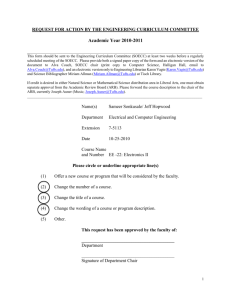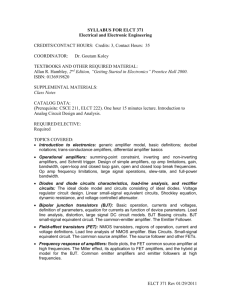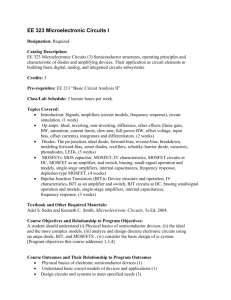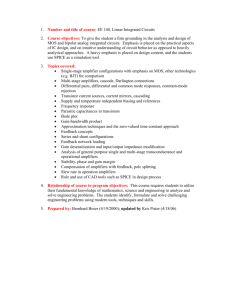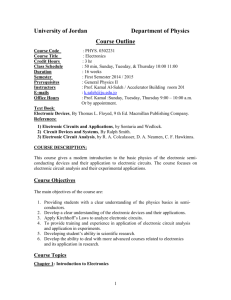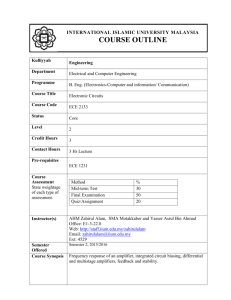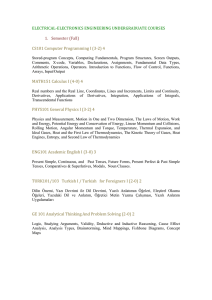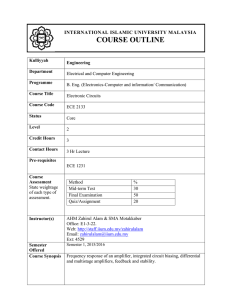PowerPoint 演示文稿
advertisement
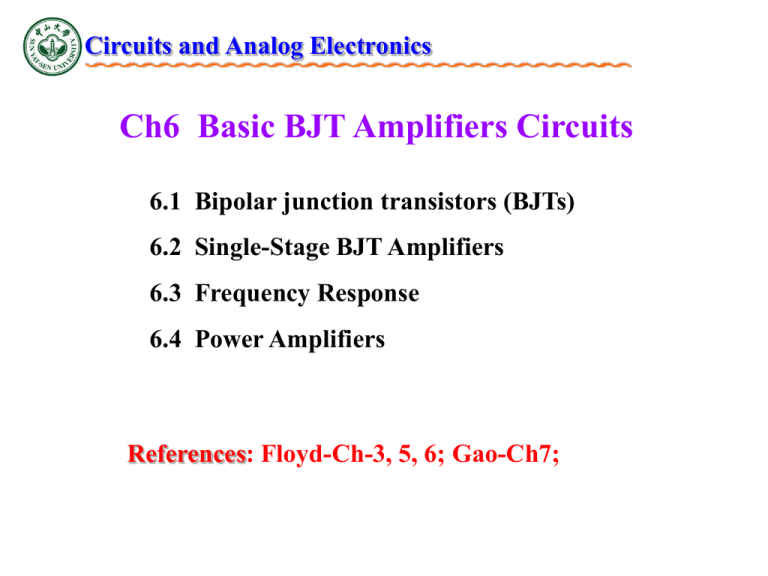
Circuits and Analog Electronics Ch6 Basic BJT Amplifiers Circuits 6.1 Bipolar junction transistors (BJTs) 6.2 Single-Stage BJT Amplifiers 6.3 Frequency Response 6.4 Power Amplifiers References: Floyd-Ch-3, 5, 6; Gao-Ch7; Ch6 Basic BJT Amplifiers Circuits 6.1 Bipolar junction transistors (BJTs) Key Words: Construction of BJT BJT in Active Mode BJT DC Model and DC Analysis C-E Circuits I-V Characteristics DC Load Line and Quiescent Operation Point BJT AC Small-Signal Model Ch6 Basic BJT Amplifiers Circuits 6.1 Bipolar junction transistors (BJTs) This lecture will spend some time on understanding how the bipolar junction transistor (BJT) works based on what we have known about PN junctions. One way to look at a BJT transistor is two back-to-back diodes, but it has very different characteristics. Once we understand how the BJT device operates, we will take a look at the different circuits (amplifiers) which we can build. Ch6 Basic BJT Amplifiers Circuits 6.1 Bipolar junction transistors (BJTs) Ch6 Basic BJT Amplifiers Circuits 6.1 Bipolar junction transistors (BJTs) Construction of Bipolar junction transistors Emitter-base junction Base region (very narrow) Emitter region Collector Collector region Emitter Base Collector-base junction Ch6 Basic BJT Amplifiers Circuits 6.1 Bipolar junction transistors (BJTs) Construction of Bipolar junction transistors NPN BJT shown • 3 terminals: emitter, base, and collector • 2 junctions: emitter-base junction (EBJ) and collector-base junction (CBJ) – These junctions have capacitance (high-frequency model) • BJTs are not symmetric devices – doping and physical dimensions are different for emitter and collector Ch6 Basic BJT Amplifiers Circuits 6.1 Bipolar junction transistors (BJTs) Standard bipolar junction transistor symbols Depending on the biasing across each of the junctions, different modes of operation are obtained – cutoff, active and saturation Ch6 Basic BJT Amplifiers Circuits 6.1 Bipolar junction transistors (BJTs) BJT in Active Mode Two external voltage sources set the bias conditions for active mode – EBJ is forward biased and CBJ is reverse biased Ch6 Basic BJT Amplifiers Circuits 6.1 Bipolar junction transistors (BJTs) BJT in Active Mode IE=IEN+IEP IEN Forward bias of EBJ injects electrons from emitter into base (small number of holes injected from base into emitter) Ch6 Basic BJT Amplifiers Circuits 6.1 Bipolar junction transistors (BJTs) BJT in Active Mode IB =IBN+ IEP • Most electrons shoot through the base into the collector across the reverse bias junction • Some electrons recombine with majority carrier in (P-type) base region Ch6 Basic BJT Amplifiers Circuits 6.1 Bipolar junction transistors (BJTs) BJT in Active Mode IC = ICN + ICBO Electrons that diffuse across the base to the CBJ junction are swept across the CBJ depletion region to the collector. Ch6 Basic BJT Amplifiers Circuits 6.1 Bipolar junction transistors (BJTs) BJT in Active Mode IE=IEN+IEP IEN IC = ICN + ICBO IE = IB + IC Let ICN=IE IB=IBN+IEP IC ---common-base current gain IE IC (1-) = IB + ICBO Ch6 Basic BJT Amplifiers Circuits 6.1 Bipolar junction transistors (BJTs) BJT in Active Mode IE=IEN+IEP IEN IC IE IB=IBN+IEP IC=ICN+ICBO IE=IB+IC IC (1-)= IB+ICBO Let Beta: IC IB 1 I C I B (1 ) I CBO ---common-emitter current gain I E I C I B (1 ) I B I C I B I CEO I B I I E C Ch6 Basic BJT Amplifiers Circuits 6.1 Bipolar junction transistors (BJTs) BJT Equivalent Circuits + iB iC vBE - IB IC + iE - + V CE VBE=Von IB - vCE BJT DC model iB + IE - •Use a simple constant-VBE model – Assume VBE = 0.7V Ch6 Basic BJT Amplifiers Circuits 6.1 Bipolar junction transistors (BJTs) BJT DC Analysis • Make sure the BJT current equations and region of operation match VBE > 0, VBC < 0, VE < VB <VC • Utilize the relationships (β and α) between collector, base, and emitter currents to solve for all currents I E I C I B (1 ) I B I C I B I I E C Ch6 Basic BJT Amplifiers Circuits 6.1 Bipolar junction transistors (BJTs) C-E Circuits I-V Characteristics Base-emitter Characteristic(Input characteristic) i B f (v BE ) vCE C Ch6 Basic BJT Amplifiers Circuits 6.1 Bipolar junction transistors (BJTs) C-E Circuits I-V Characteristics Collector characteristic (output characteristic) iC f (VCE ) iB C iB = 40 μA Ch6 Basic BJT Amplifiers Circuits 6.1 Bipolar junction transistors (BJTs) C-E Circuits I-V Characteristics Collector characteristic (output characteristic) iC f (VCE ) iB C Ch6 Basic BJT Amplifiers Circuits 6.1 Bipolar junction transistors (BJTs) C-E Circuits I-V Characteristics Collector characteristic Saturation Saturation occurs when the supply voltage, VCC, is across the total resistance of the collector circuit, RC. IC(sat) = VCC/RC Vsat Once the base current is high enough to produce saturation, further increases in base current have no effect on the collector current and the relationship IC = IB is no longer valid. When VCE reaches its saturation value, VCE(sat), the base-collector junction becomes forward-biased. Ch6 Basic BJT Amplifiers Circuits 6.1 Bipolar junction transistors (BJTs) C-E Circuits I-V Characteristics Collector characteristic When IB = 0, the transistor is in cutoff and there is essentially no collector current except for a very tiny amount of collector leakage current, ICEO, which can usually be neglected. IC 0. Cutoff In cutoff both the base-emitter and the base-collector junctions are reverse-biased. Ch6 Basic BJT Amplifiers Circuits 6.1 Bipolar junction transistors (BJTs) C-E Circuits I-V Characteristics Collector characteristic linearity Ch6 Basic BJT Amplifiers Circuits 6.1 Bipolar junction transistors (BJTs) Discussion of an amplification effect vi Ri iB vo RL iC vCE vBE Ri RL iB iC With iB iC vi vo E.g. for common-base configuration transistor: vo Av 50 ~ 300 vi Ch6 Basic BJT Amplifiers Circuits 6.1 Bipolar junction transistors (BJTs) DC Load Line and Quiescent Operation Point Q-point VCC ICQ . Q VCEQ Base-emitter loop: I B DC load line Collector-emitter loop: VCC VBE VCC 40( A) Rb Rb vCE VCC iC RC 10 iC 4k Ch6 Basic BJT Amplifiers Circuits 6.1 Bipolar junction transistors (BJTs) BJT AC Small-Signal Model + iB iC vBE - iB iE + + vCE vbe - - i b rbe ic ib + vce - ie rbe 300 (1 ) 26(mV ) I E (mA) • We can create an equivalent circuit to model the transistor for small signals – Note that this only applies for small signals (vbe < VT) • We can represent the small-signal model for the transistor as a voltage controlled current source (i E I S e vBE / VT ) or a current-controlled current source (ic = ib). signals, approximate exponential curve with a linear line. • For small enough v BE / VT e I I i C S E Ch6 Basic BJT Amplifiers Circuits 6.1 Bipolar junction transistors (BJTs) VBE 0.7V BJT fundamentals: I E IC I B 1 I B IC IC I B Summary for three types of diodes: Input Output Functions C-C C-E C-B IB IB IB IE IC IC Z at Zin Z at Zin Z at Zin Vat Vin Vat Vin Ch6 Basic BJT Amplifiers Circuits 6.2 Single-Stage BJT Amplifiers Key Words: Common-Emitter Amplifier Graphical Analysis Small-Signal Models Analysis Common-Collector Amplifier Common-Base Amplifier Ch6 Basic BJT Amplifiers Circuits 6.2 Single-Stage BJT Amplifiers C-E Amplifiers To operate as an amplifier, the BJT must be biased to operate in active mode and then superimpose a small voltage signal vbe to the base. DC + small signal coupling capacitor (only passes ac signals) C2 iC iB RC C1 vi vBE iB ic vCE vo vi iB iB iC iC vO Ch6 Basic BJT Amplifiers Circuits 6.2 Single-Stage BJT Amplifiers C-E Amplifiers + Vi Vi Vi Vi Ch6 Basic BJT Amplifiers Circuits 6.2 Single-Stage BJT Amplifiers C-E Amplifiers Apply a small signal input voltage and see ib i B I B ib vBE=vi+VBE Ch6 Basic BJT Amplifiers Circuits 6.2 Single-Stage BJT Amplifiers C-E Amplifiers See how ib translates into vce. • vi = 0 IB、IC、VCE vi 0 iC=ic+IC i B I B ib iC I C i C vCE VCE vce • VoM ViM f (o ) f (i ) • vo out of phase with vi vCE=vce+VCE Ch6 Basic BJT Amplifiers Circuits 6.2 Single-Stage BJT Amplifiers C-E Amplifiers Considering VC (all the capaertors are replaced by open circuits) Considering Vi (all the capaertors are replaced by short circuits) Ch6 Basic BJT Amplifiers Circuits 6.2 Single-Stage BJT Amplifiers C-E Amplifiers Considering VC (all the capaertors are replaced by open circuits) Considering Vi (all the capaertors are replaced by short circuits) Ch6 Basic BJT Amplifiers Circuits 6.2 Single-Stage BJT Amplifiers Graphical Analysis • Can be useful to understand the operation of BJT circuits. • First, establish DC conditions by finding IB (or VBE) • Second, figure out the DC operating point for IC VCC Can get a feel for whether the BJT will stay in active region of operation – What happens if RC is larger or smaller? Ch6 Basic BJT Amplifiers Circuits 6.2 Single-Stage BJT Amplifiers Graphical Analysis vce ic ( RC // RL ) ic RL' VCC ' VCEQ I CQ RL ' VCC Ch6 Basic BJT Amplifiers Circuits 6.2 Single-Stage BJT Amplifiers Graphical Analysis Q-point is centered on the ac load line: VCC Ch6 Basic BJT Amplifiers Circuits 6.2 Single-Stage BJT Amplifiers Graphical Analysis Q-point closer to cutoff: VCC Clipped at cutoff (cutoff distortion) Ch6 Basic BJT Amplifiers Circuits 6.2 Single-Stage BJT Amplifiers Graphical Analysis Q-point closer to saturation: VCC Clipped at cutoff (saturation distortion) Ch6 Basic BJT Amplifiers Circuits 6.2 Single-Stage BJT Amplifiers Graphical Analysis Ch6 Basic BJT Amplifiers Circuits 6.2 Single-Stage BJT Amplifiers Small-Signal Models Analysis Steps for using small-signal models 1. Determine the DC operating point of the BJT - in particular, the collector current 2. Calculate small-signal model parameters: rbe 3. Eliminate DC sources – replace voltage sources with shorts and current sources with open circuits 4. Replace BJT with equivalent small-signal models 5. Analysis Ch6 Basic BJT Amplifiers Circuits 6.2 Single-Stage BJT Amplifiers Small-Signal Models Analysis Example 1 VC ( I B I C ) R I B R b VBE I E R e VC VBE IB Rb (1 )( R Re ) IC ≈ βIB, IE = IC + IB = (1+β)IB VCE VC I C RC I E ( R Re ) Ch6 Basic BJT Amplifiers Circuits 6.2 Single-Stage BJT Amplifiers Small-Signal Models Analysis Example 1 Ch6 Basic BJT Amplifiers Circuits 6.2 Single-Stage BJT Amplifiers Small-Signal Models Analysis Example 2 VB Rb 2 VCC Rb1 Rb 2 IC I E vs IB VB VBE V B/ Re Re IC VCE VCC I C ( R C R e ) Ch6 Basic BJT Amplifiers Circuits 6.2 Single-Stage BJT Amplifiers Small-Signal Models Analysis There are three basic configurations for single-stage BJT amplifiers: – Common-Emitter – Common-Base – Common-Collector e N P N b VBB e c c b RC VCC (a) VE VB VC VBB N P N e Rc b VCC (b) VE VB VC VBB N P N Re c VCC (c) VE VB VC Ch6 Basic BJT Amplifiers Circuits 6.2 Single-Stage BJT Amplifiers Common-Collector Amplifier VCC I B Rb VBE I E Re I B Rb VBE (1 ) I B Re IB VCC VBE VCC Rb (1 ) Re Rb 1 Re I C I B VCC VCE I E Re VCE I C Re VCE VCC I C Re (a) 共集电极电路 Note : Vo is slightly less than Vi due to the voltage drop introduced by VBE AV 1 Ch6 Basic BJT Amplifiers Circuits 6.2 Single-Stage BJT Amplifiers Common-Collector Amplifier The last basic configuration is to tie the collector to a fixed voltage, drive an input signal into the base and observe the output at the emitter. (a) 共集电极电路 Ch6 Basic BJT Amplifiers Circuits 6.2 Single-Stage BJT Amplifiers Common-Collector Amplifier Let’s find Av, Ai: Vo I e ( Re // RL ) I b (e1 )( Re // RL ) Vi I b [rbe (1 )( Re // RL )] I b rbe I e ( Re // RL ) (1 )( Re // RL ) ( Re // RL ) AV 1 Vi rbe (1 )( Re // RL ) rbe (1 )( Re // RL ) VO Ch6 Basic BJT Amplifiers Circuits 6.2 Single-Stage BJT Amplifiers Common-Collector Amplifier Let’s find Av, Ai: I o RL I e ( Re // RL ) (1 ) I b ( Re // RL ) (1 )( Re // RL ) Io Ib RL I b (rbe (1 )( Re // RL )) ( I i I b ) Rb rbe (1 )( Re // RL ) Rb (1 )( Re // RL ) Rb Ii Ib Ib Rb Rb (1 )( Re // RL ) Rb (1 )( Re // RL ) Ai RL (1 )( Re // RL ) Rb RL Ai (1 )( Re // RL ) >>1 RL (1 )( Re // RL ) << Rb Ch6 Basic BJT Amplifiers Circuits 6.2 Single-Stage BJT Amplifiers Common-Collector Amplifier Let’s find Ri: Ri vi ib rbe ie ( Re // RL ) ib rbe (1 )( Re // RL ) Ri vi rbe (1 )( Re // R L ) ib Ri Ri // Rb [rbe (1 )( Re // RL )] // Rb Rb // ( Re // RL ) Ch6 Basic BJT Amplifiers Circuits 6.2 Single-Stage BJT Amplifiers Common-Collector Amplifier Let’s find Ro: I Re I I e I I Re I e I I Re I e I Re 1 Ib I I Re Ro (b) Ie I Re I I I Re I b I b v v (1 ) Re rbe Rs // Rb v 1 Ro 1 i 1 Re (rbe Rs // Rb ) (1 ) (rbe Rs // Rb ) Re // 1 Ch6 Basic BJT Amplifiers Circuits 6.2 Single-Stage BJT Amplifiers Common-Collector Amplifier I I Re Ri (a) Ri [rbe (1 )( Re // RL )] // Rb Ro (b) (rbe Rs // Rb ) Ro Re // 1 Ch6 Basic BJT Amplifiers Circuits 6.2 Single-Stage BJT Amplifiers Common-Collector Amplifier AV VO Vi Ai ( Re // RL ) 1 rbe (1 )( Re // RL ) (1 )( Re // RL ) >>1 RL Ri [rbe (1 )( Re // RL )] // Rb (a) 共集电极电路 (rbe Rs // Rb ) Ro Re // 1 C-C amp characteristics: • Gain is less than unity, but close (to unity) since β is large and rbe is small. • Also called an emitter follower since the emitter follows the input signal. • Input resistance is higher, output resistance is lower. - Used for connecting a source with a large Rs to a load with low resistance. Ch6 Basic BJT Amplifiers Circuits 6.2 Single-Stage BJT Amplifiers Common-Base Amplifier Ground the base and drive the input signal into the emitter Rc (a) 共基极电路 VB VBE I E R e VB VCC R b2 R b1 R b 2 VCE VCC I C RC I E Re VCC I C ( RC Re ) IC I E IB IC VB VBE VB Re Re Ch6 Basic BJT Amplifiers Circuits 6.2 Single-Stage BJT Amplifiers Common-Base Amplifier Ro Ri (a) 共基极电路 Av ic ( Rc // RL ) ( Rc // RL ) ib rbe rbe R R C C (R R ) I ( R R ) I C L C L E 1 A i o r (1 ) IC Ii be r be rbe // Re R i= (1 ) Ro≈RC (1 ) For RL<<RC, Ai // Re (1 ) 1since I E I C Ch6 Basic BJT Amplifiers Circuits 6.2 Single-Stage BJT Amplifiers Common-Base Amplifier RC ( R R ) I RC C L A i o (1 ) RC RL Ii For RL<<RC, Ai Av ( Rc // RL ) (1 ) 1 rbe rbe rbe // R R i= e (1 ) (1 ) Ro≈RC (a) 共基极电路 CB amp characteristics: • current gain has little dependence on β • is non-inverting • most commonly used as a unity-gain current amplifier or current buffer and not as a voltage amplifier: accepts an input signal current with low input resistance and delivers a nearly equal current with high output impedance • most significant advantage is its excellent frequency response Ch6 Basic BJT Amplifiers Circuits 6.3 Frequency Response Key Words: Basic Concepts High-Frequency BJT Model Frequency Response of the CE Amplifier Ch6 Basic BJT Amplifiers Circuits 6.3 Frequency Response Basic Concepts 1.0V 0.5V 0V -0.5V -1.0V 0.5ms V(1) 1.0ms 1.5ms 2.0ms 2.5ms V(2) Time 3.0ms 3.5ms 4.0ms Ch6 Basic BJT Amplifiers Circuits 6.3 Frequency Response Basic Concepts VO (t ) 1.0V 0.5V 0V -0.5V -1.0V 0.5ms V(1) 1.0ms 1.5ms 2.0ms 2.5ms V(2) Time 3.0ms 3.5ms 4.0ms Ch6 Basic BJT Amplifiers Circuits 6.3 Frequency Response Basic Concepts 800mV 600mV 400mV 200mV 0V 0Hz V(2) 2KHz V(1) 4KHz 6KHz 8KHz 10KHz Frequency 12KHz 14KHz 16KHz 18KHz 1.0V 0.5V 0V 10Hz V(2) 100Hz 1.0KHz 10KHz 100KHz 1.0MHz 20KHz Ch6 Basic BJT Amplifiers Circuits 6.3 Frequency Response Basic Concepts A v Av ( f ) ( f ) Lower cut off frequency or A Av ( ) ( ) Upper cut off frequency The drops of voltage gain (output/input) is mainly due to: 1、Increasing reactance of Cs , Cc , Ce (at low f) 2、Porasitic capacetine elements of the net work (at high f) 3、Dissappearance of changing current(for trasformer coupled amp) Ch6 Basic BJT Amplifiers Circuits 6.3 Frequency Response High-Frequency BJT Model In BJTs, the PN junctions (EBJ and CBJ) also have capacitances associated with them C rbe C C C rbe C' C' Ch6 Basic BJT Amplifiers Circuits 6.3 Frequency Response Frequency Response of the CE Amplifier rbe C' vs There are three capacitors in the circuit. At the mid frequency band, these are considered to be short circuits and internal capacitors C',and C'are considered to be open circuits. C' Ch6 Basic BJT Amplifiers Circuits 6.3 Frequency Response Frequency Response of the CE Amplifier At low frequencies, C1, C2 are an open circuit and the gain is zero. Thus C1 has a high pass effect on the gain, i.e. it affects the lower cutoff frequency of the amplifier. vs 1 C1 ( Rs Rb1 // Rb2 // rbe ) f L1 2 is the time constant for C2. 2 1 1 21 ---is neglected Ch6 Basic BJT Amplifiers Circuits 6.3 Frequency Response Frequency Response of the CE Amplifier 1 C1 ( Rs Rb1 // Rb2 // rbe ) 2 1 ---is neglected Capacitor Ce is an open circuit. The pole time constant is given by the resistance multiplied by Ce. vs ( Rb // Rs rbe ) // Re Ce 1 e f L 1.1 f 2 L1 f L 2 f Le 2 2 f Le 1 2e Ch6 Basic BJT Amplifiers Circuits 6.3 Frequency Response Frequency Response of the CE Amplifier At high frequencies, C1, C2 Ce are all short circuit. The frequency that dominates is the lowest pole frequency. vs The time constant is neglected for C' ( RL 1 jC' ) rbe C ( Rb // Rs // rbe )C C' C' fH 1 2C In summary:the lower cut off frequency is determined by network capacitence. e.g.C1 C2 , Ce The higher cut off frequency is determined by the parasitic ferquency of the BJT. e.g. C Ch6 Basic BJT Amplifiers Circuits 6.3 Frequency Response Frequency Response of the CE Amplifier rbe C' j A v Avm vs C' (1 j f fL f f )(1 j ) fL fH f For f L f f H , 0 Av Avm — mid - frequency fH f j f fL For f f L ( f f H ), 0, Av Avm — low - frequency f fH 1 j fL fL 1 For f f H ( f f L ) 0, Av Avm — High frequency f f 1 j fH f , fL Ch6 Basic BJT Amplifiers Circuits 6.3 Frequency Response Frequency Response of the CE Amplifier rbe vs j A v Avm fL (1 j L 1 2 2 L f fL f f )(1 j ) fL fH fH H 1 2 2 H C' C' Ch6 Basic BJT Amplifiers Circuits 6.3 Frequency Response Frequency Response of the CE Amplifier decade decade 0 Ch6 Basic BJT Amplifiers Circuits 6.4 Power Amplifiers Key Words: Power Calculation Class-A, B, AB Amplifiers Complementary Symmetry(Push-Pull) Amplifier Biasing the Push-Pull Amplifier (OCL) Single-Supply Push-Pull Amplifier (OTL) Ch6 Basic BJT Amplifiers Circuits 6.4 Power Amplifiers An Analog Electronics System Block Sensor Energy conversion Voltage Amplifiers Power Amplifiers Signal Amplifiers Load Energy conversion Ch6 Basic BJT Amplifiers Circuits 6.4 Power Amplifiers The output power delivered to the load RL: Po Vom I om 2 1 Vom I om 2 2 The average power delivered by the supply: T T 1 1 PS VCC iC (t )dt VCC iC (t )dt VCC I C T 0 T 0 The efficiency in converting supply power to useful output power is defined as P OM 100% PS Ch6 Basic BJT Amplifiers Circuits 6.4 Power Amplifiers Power Calculation The DC power by the supply PC VCEQ I CQ (VCC I CQ RC ) I CQ 2 PS I CQ RC The DC power delivered to BJT by the supply Ch6 Basic BJT Amplifiers Circuits 6.4 Power Amplifiers Power Calculation The average power dissipated as heat in the BJT: 1 T PT vCE iC dt T 0 1 T ( I CQ I m cos t )(VCEQ Vm cos t ) T 0 1 I CQVCEQ I mVm PC PCL 2 Ch6 Basic BJT Amplifiers Circuits 6.4 Power Amplifiers Class-A Amplifiers Class-B Amplifiers Ch6 Basic BJT Amplifiers Circuits 6.4 Power Amplifiers Class-AB Amplifiers Ch6 Basic BJT Amplifiers Circuits 6.4 Power Amplifiers Complementary Symmetry Power Amplifier (Class-B) Ch6 Basic BJT Amplifiers Circuits 6.4 Power Amplifiers Complementary Symmetry Power Amplifier (Class-B) 2 2 V sin t 1 VCCVon on PT 1 sin tdt dt 0 0 2 RL RL Von 2 2 1 VCCVon sin tdt sin tdt 0 0 2 RL RL Von 2 1 1 VCCVon sin tdt 1 cos 2tdt 0 0 2 RL RL 2 Von 2 1 VCCVon Von 2 1 VCCVon Von 2 1 VCCVon 2 cos t 0 2 RL 2 RL 2 RL 2 RL RL 4 Ch6 Basic BJT Amplifiers Circuits 6.4 Power Amplifiers Complementary Symmetry Power Amplifier (Class-B) 2 I om Vom 1 Vom PO 2 2 2 RL POM Assuming vo Vom sin t 1 PT 1 2 0 1 vCE iC d t 2 2 1 VCC 2 RL vCE VCC vo vO V v 0 CC O d t RL 2 1 VCCVOm VOm RL 4 PT 1 0 for VOm 0 VOm VCC 2 4 VCC PT PT 1 PT 2 2 RL 2 VCC 4 PT 1 RL 4 Note: PT represents the amount of power dissipated by the BJT as heat Ch6 Basic BJT Amplifiers Circuits 6.4 Power Amplifiers Complementary Symmetry Power Amplifier (Class-B) 2 I om Vom 1 Vom PO 2 2 2 RL 2 1 VCC POM 2 RL 2 V 4 VOm VCC PT 1 CC RL 4 2 4 VCC PT PT 1 PT 2 2 RL 2 2VCC PE PT PO RL 2 1 VCC P O 2 RL 2 2 VCC PE 4 Note that for class A: η﹦25﹪ ~ 50﹪ RL class B: η﹦78.5﹪ class AB: η=25﹪ ~ 78.5﹪ =78.5% Ch6 Basic BJT Amplifiers Circuits 6.4 Power Amplifiers Complementary Symmetry Power Amplifier (Class-B) Crossover distortion Ch6 Basic BJT Amplifiers Circuits 6.4 Power Amplifiers Biasing the Push-Pull Amplifier (Class-AB) (OCL) To overcome crossover distortion, the biasing is adjusted to just overcome the VBE of the transistors; this results in a modified form of operation called class AB. In class AB operation, the push-pull stages are biased into slight conduction, even when no input signal is present. }VCC }VCC Power Calculation is the same as class-B Ch6 Basic BJT Amplifiers Circuits 6.4 Power Amplifiers Single-Supply Push-Pull Amplifier (OTL) The circuit operation is the same as that described previously, except the bias is set to force the output emitter voltage to be VCC/2 instead of zero volts used with two supplies. Because the output is not biased at zero volts, capacitive coupling for the input and output is necessary to block the bias voltage from the source and the load resistor.
